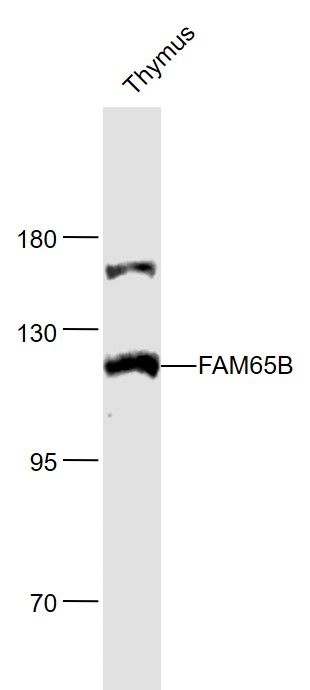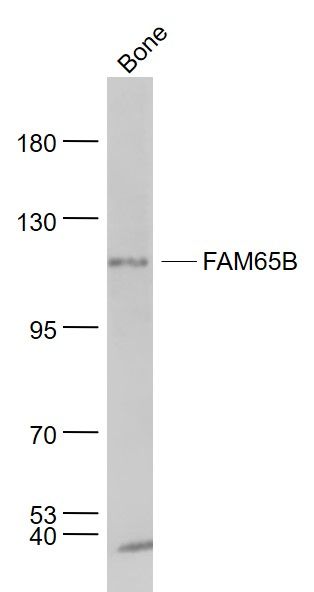FAM65B Polyclonal Antibody
Purified Rabbit Polyclonal Antibody (Pab)
- 产品详情
- 实验流程
Application
| WB, IHC-P, IHC-F, IF, ICC, E |
|---|---|
| Primary Accession | Q9Y4F9 |
| Reactivity | Rat, Pig, Dog, Bovine |
| Host | Rabbit |
| Clonality | Polyclonal |
| Calculated MW | 118519 Da |
| Physical State | Liquid |
| Immunogen | KLH conjugated synthetic peptide derived from human FAM65B |
| Epitope Specificity | 201-300/1068 |
| Isotype | IgG |
| Purity | affinity purified by Protein A |
| Buffer | 0.01M TBS (pH7.4) with 1% BSA, 0.02% Proclin300 and 50% Glycerol. |
| SUBCELLULAR LOCATION | Mitochondrion and Cytoplasm; cytoskeleton. Cell projection; filopodium. Detected in cellular filopodia. |
| SIMILARITY | Belongs to the FAM65 family. |
| Post-translational modifications | Asn-41 was reported (PubMed:16335952) to be N-glycosylated; however as this position is probably not extracellular, the in vivo relevance is not proven. |
| Important Note | This product as supplied is intended for research use only, not for use in human, therapeutic or diagnostic applications. |
| Background Descriptions | Making up nearly 6% of the human genome, chromosome 6 contains around 1,200 genes within 170 million base pairs of sequence. Deletion of a portion of the q arm of chromosome 6 is associated with early onset intestinal cancer suggesting the presence of a cancer susceptibility locus. Porphyria cutanea tarda is associated with chromosome 6 through the HFE gene which, when mutated, predisposes an individual to developing this porphyria. Notably, the PARK2 gene, which is associated with Parkinson's disease, and the genes encoding the major histocompatiblity complex proteins, which are key molecular components of the immune system and determine predisposition to rheumatic diseases, are also located on chromosome 6. Stickler syndrome, 21-hydroxylase deficiency and maple syrup urine disease are also associated with genes on chromosome 6. A bipolar disorder susceptibility locus has been identified on the q arm of chromosome 6. The C6orf32 gene product has been provisionally designated C6orf32 pending further characterization. |
| Gene ID | 9750 |
|---|---|
| Other Names | Rho family-interacting cell polarization regulator 2, RIPOR2 |
| Target/Specificity | Isoform 1 is present in the brain. Isoform 2 is expressed during differentiation of fetal primary myoblasts. Also shows marked expression during cytotrophoblast differentiation. |
| Dilution | WB=1:500-2000,IHC-P=1:100-500,IHC-F=1:100-500,ICC=1:100-500,IF=1:100-500,ELISA=1:5000-10000 |
| Format | 0.01M TBS(pH7.4) with 1% BSA, 0.09% (W/V) sodium azide and 50% Glyce |
| Storage | Store at -20 °C for one year. Avoid repeated freeze/thaw cycles. When reconstituted in sterile pH 7.4 0.01M PBS or diluent of antibody the antibody is stable for at least two weeks at 2-4 °C. |
| Name | RIPOR2 |
|---|---|
| Function | Acts as an inhibitor of the small GTPase RHOA and plays several roles in the regulation of myoblast and hair cell differentiation, lymphocyte T proliferation and neutrophil polarization (PubMed:17150207, PubMed:23241886, PubMed:24687993, PubMed:24958875, PubMed:25588844, PubMed:27556504). Inhibits chemokine-induced T lymphocyte responses, such as cell adhesion, polarization and migration (PubMed:23241886). Involved also in the regulation of neutrophil polarization, chemotaxis and adhesion (By similarity). Required for normal development of inner and outer hair cell stereocilia within the cochlea of the inner ear (By similarity). Plays a role for maintaining the structural organization of the basal domain of stereocilia (By similarity). Involved in mechanosensory hair cell function (By similarity). Required for normal hearing (PubMed:24958875). |
| Cellular Location | Cytoplasm. Cytoplasm, cytoskeleton. Cell projection, filopodium. Cell projection, stereocilium {ECO:0000250|UniProtKB:Q80U16}. Cell projection, stereocilium membrane {ECO:0000250|UniProtKB:Q7TP54}. Apical cell membrane {ECO:0000250|UniProtKB:Q7TP54}. Note=Localized in the cytoplasm in cells undergoing mitosis (PubMed:17150207). Colocalized with F-actin (PubMed:17150207). Localized with RHOC within the basal domain of hair cell stereocilia, near the taper region (By similarity). Detected in punctate pattern forming a circumferential ring at the stereocilia base (By similarity). Localized to the apical stereocilia of inner and outer hair cells (By similarity). Not detected as a membrane-associated protein in stereocilia (By similarity). {ECO:0000250|UniProtKB:Q7TP54, ECO:0000250|UniProtKB:Q80U16, ECO:0000269|PubMed:17150207} [Isoform 2]: Cytoplasm. Note=Accumulates at the leading edge of polarized neutrophils in a chemokine-dependent manner (PubMed:25588844). |
| Tissue Location | Expressed in primary fetal mononuclear myoblast (PubMed:17150207). Expressed strongly in naive T lymphocytes (PubMed:27556504). Expressed weakly in activated T lymphocytes (at protein level) (PubMed:27556504). Expressed in blood cells and adult tissues of hematopoietic origin, such as the secondary lymphoid organs (PubMed:23241886). Expressed in cytotrophoblast (PubMed:9055809) |
Research Areas
For Research Use Only. Not For Use In Diagnostic Procedures.
Application Protocols
Provided below are standard protocols that you may find useful for product applications.
终于等到您。ABCEPTA(百远生物)抗体产品。
点击下方“我要评价 ”按钮提交您的反馈信息,您的反馈和评价是我们最宝贵的财富之一,
我们将在1-3个工作日内处理您的反馈信息。
如有疑问,联系:0512-88856768 tech-china@abcepta.com.
¥ 1,500.00
Cat# AP54840























 癌症的基本特征包括细胞增殖、血管生成、迁移、凋亡逃避机制和细胞永生等。找到癌症发生过程中这些通路的关键标记物和对应的抗体用于检测至关重要。
癌症的基本特征包括细胞增殖、血管生成、迁移、凋亡逃避机制和细胞永生等。找到癌症发生过程中这些通路的关键标记物和对应的抗体用于检测至关重要。 为您推荐一个泛素化位点预测神器——泛素化分析工具,可以为您的蛋白的泛素化位点作出预测和评分。
为您推荐一个泛素化位点预测神器——泛素化分析工具,可以为您的蛋白的泛素化位点作出预测和评分。 细胞自噬受体图形绘图工具为你的蛋白的细胞受体结合位点作出预测和评分,识别结合到自噬通路中的蛋白是非常重要的,便于让我们理解自噬在正常生理、病理过程中的作用,如发育、细胞分化、神经退化性疾病、压力条件下、感染和癌症。
细胞自噬受体图形绘图工具为你的蛋白的细胞受体结合位点作出预测和评分,识别结合到自噬通路中的蛋白是非常重要的,便于让我们理解自噬在正常生理、病理过程中的作用,如发育、细胞分化、神经退化性疾病、压力条件下、感染和癌症。







